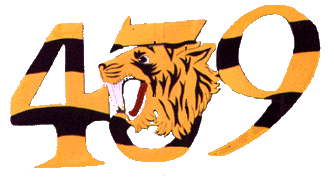|
Red section gallantly sought to divert the gunners from the rest of the formation by strafing the gun positions. Erle was well covered with bomb clusters which added to a fire already burning in the centre of the town and started several new ones. F/O Art Derouin then discovered some vehicle which he strafed until his
cannons were empty; three were destroyed.
After one sortie on the 28th had been recalled because of duff weather the squadron got away on a wing show with No. 440 to destroy an enemy headquarters located in a chateau near Anholt. No. 439 went in first to make three direct hits on the chateau. Other 500 lb. bombs fell on
another building north of the target, touching off a large
explosion followed by vivid yellow and orange flames. Both the chateau and the other building were destroyed.
|
Intentionally
left blank
|
Intentionally
left blank
|
A "cab rank" effort later in the day was less successful as the pilots, after a long wait for orders were given a target which they could not attack because of the very low cloud base. While waiting for instructions the aircraft were subjected to considerable flak from Isselburg which put some holes in Hap Herod's
Tiffie.
The squadron's last operation from Eindhoven was an interesting innovation. The advance of the Army from the Rhine bridgehead had cut off a number of towns and villages and it was decided to shower these localities with
surrender leaflets urging the Nazi garrisons to cease their futile resistance. No. 439 sent out six aircraft on a leaflet dropping raid, each machine carrying small
"nickel" bombs that were loaded with surrender chits. Low cloud forced the pilots to fly at a height where they were exposed to profuse light flak but by weaving violently they escaped damage.
|
|
Emmerich,
Wesel, Anholt, Bocholt, Reken, Borken, Haltern, Coesfeld and Dulmen were the targets for the bombs dropped by F/L Davis, WO Kidd, and F/Os
Cleghorn, Marlatt, Hallford and Kubicki. While the squadron was carrying out these operations on 28 March the Army was beginning its advance from the Rhine bridgehead to the Elbe and the Typhoon wing was preparing to move forward to keep in touch with the troops. For some time there had been unorthodox, but potent, signs that a move was impending.
No. 439 had now been stationed at B.78 Eindhoven for six months, the longest time it ever spent in one place overseas, and was feeling quite at home there. It is a service maxim that such a feeling is an infallible indication that a change is coming. Then, to destroy any last possible doubts the pilots packed their bags and shifted quarters from their
"convent" in Eindhoven to a fine officers' mess (ex
Luftwaffe) which they had acquired at Zeelst, nearer the airfield.
  
Copyright
©1998-2016 Michael T. Melnick. All rights reserved
the
unofficial homepage of  Tiger
Squadron Tiger
Squadron
.
.
|